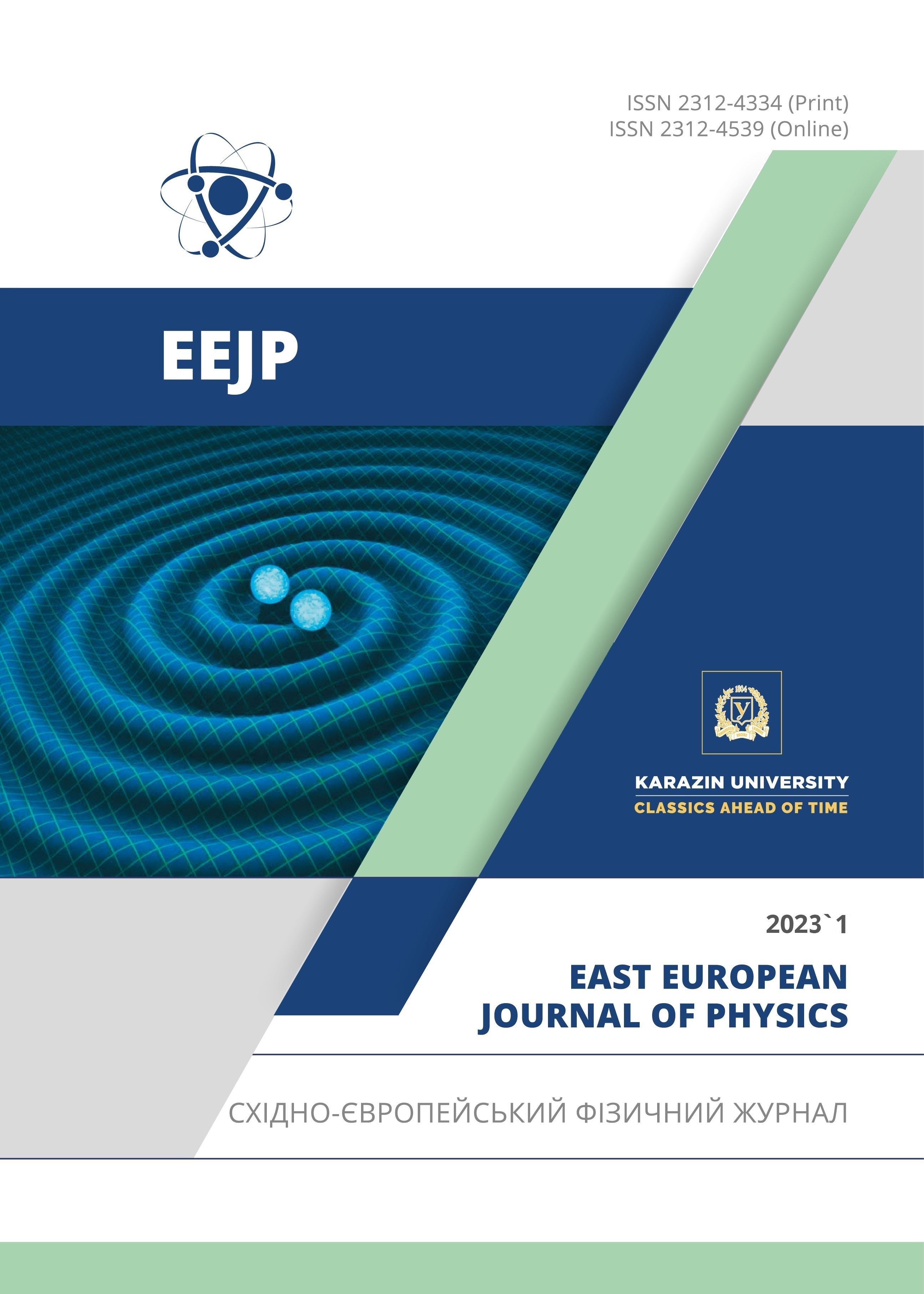The Electronic and Thermodynamic Properties of Ternary Rare Earth Metal Alloys
Abstract
This article uses the FP-LAPW approach within the DFT method, and the quasi-harmonic Debye model to investigate the electronic and thermodynamic properties of intermetallic rare earth materials (such as SmInZn, SmInCd, and SmTlZn). Thermodynamic properties were determined by the quasi-harmonic Debye model, whereas the FP-LAPW approaches within DFT method were utilized to derive electronic properties. The calculated structural parameters and the available experimental data have been examined, and it was observed that there was a good agreement between available experimental and calculated values of structural parameters. The electronic behavior of SmInZn, SmInCd and SmTlZn compounds shows the metallic character. We have examined a few thermodynamic characteristics. All calculated characteristics were found to match experimental or theoretical calculations.
Downloads
References
R.D. Hoffmann, and R. Pöttgen, Z. Kristallogr. 216, 127 (2001).
M.D. Klicpera, F. Malý, I. Puente-Orench, and P. Javorský, J. Alloys Compd. 822, 153595 (2020). https://doi.org/10.1016/j.jallcom.2019.153595
Mishra, U. Subbarao, S. Roy, S.C. Sarma, D. Mumaddi, S. Sarkar, and S.C. Peter, Inorg. Chem. 57, 12576 (2018). https://doi.org/10.1021/acs.inorgchem.8b01650
K. Sun, H. Yao, E. Fradkin, and S.A. Kivelson, Phys. Rev. Lett. 103, 046811 (2009). https://doi.org/10.1103/PhysRevLett.103.046811
L. Bessais, “Structure and Magnetic Properties of Intermetallic Rare-Earth-Transition-Metal Compounds: A Review”, Materials, 15, 201 (2022). https://doi.org/10.3390/ma15010201
E. Burzo, “Exchange Interactions and Transition Metal Moments in Rare-Earth Compounds”, J. Synchrotron Investig. 12, 431 (2018). https://doi.org/10.1134/S1027451018030072
M. Duchna, and I. Cieślik, “Rare Earth Elements in New Advanced Engineering Applications”, Rare Earth Elements - Emerging Advances, Technology Utilization, and Resource Procurement, (2022). https://doi.org/10.5772/intechopen.109248
M. Traore, A. Gong, Y. Wang, L. Qiu, Y. Bai, W. Zhao, Y. Liu, et al., “Research progress of rare earth separation methods and technologies”, Journal of Rare Earths, (2022). https://doi.org/10.1016/j.jre.2022.04.009
A. Fert, F.N. Van Dau, Comptes Rendus Physique, 20(7-8), 817 (2019). https://doi.org/10.1016/j.crhy.2019.05.020
V. Balaram, “Rare earth elements: A review of applications, occurrence, exploration, analysis, recycling, and environmental impact”, Geoscience Frontiers, 10(4), 1285 (2019). https://doi.org/10.1016/j.gsf.2018.12.005
G. Barakos, H. Mischo, and J. Gutzmer, A forward look into the US rare-earth industry; How potential mines can connect to the global REE market?, Mining Engineering, (2018), pp. 30-37. https://thoriumenergyalliance.com/wp-content/uploads/2020/02/REE-GeorgeNabeelhighlights.pdf
W. Gwenzi, L. Mangori, C. Danha, N. Chaukura, N. Dunjana, and E. Sanganyado, “Sources, behaviour, and environmental and human health risks of high-technology rare earth elements as emerging contaminants”, The Science of the Total Environment, 636, 299-313, (2018). https://doi.org/10.1016/j.scitotenv.2018.04.235
J. Kang, and A.M. Kang, “Trend of the research on rare earth elements in environmental science”, Environ. Sci. Pollut. Res. 27, 14318 (2020). https://doi.org/10.1007/s11356-020-08138-z
M.Y. Raïâ, R. Masrour, A. Jabar, M. Hamedoun, A. Rezzouk, A. Hourmatallah, N. Benzakour, et al., Journal of Physics and Chemistry of Solids, 163, 110581 (2022). https://doi.org/10.1016/j.jpcs.2022.110581
M. Jirsa, M. Rameš, and M. Muralidhar, Acta Phys. Pol. A, 113, 223 (2008). http://przyrbwn.icm.edu.pl/APP/PDF/113/a113z1054.pdf
D.J. Garcı́a, V. Vildosola, and P. Cornaglia, Condensed Matter, 32(28), 285803 (2019). https://doi.org/10.1088/1361-648X/ab7e5a
X.B. Liu, and Z. Altounian, “First-principles calculation on the Curie temperature of GdFeSi”, J. Appl. Phys. 107, 09E103 (2010). https://doi.org/10.1063/1.3364048
S. Talakesh, and Z. Nourbakhsh, “The density functional study of structural, electronic, magnetic and Thermodynamic properties of XFeSi (X=Gd, Tb, La) and GdRuSi compounds”, J. Supercond. Novel Magn. 30, 2143 (2017). https://doi.org/10.1007/s10948-017-3976-x
V.K. Pecharsky, and K.A. Gschneidner Jr, “Magnetocaloric effect and magnetic refrigeration”, J. Magn. Magn. Mater. 44-56, 200 (1999). https://doi.org/10.1016/S0304-8853(99)00397-2
J. Du, Q. Zheng, Y. Li, Q. Zhang, D. Li, and Z. Zhang, “Large magnetocaloric effect and enhanced magnetic refrigeration in ternary Gd-based bulk metallic glasses”, J. Appl. Phys. 103, 023918 (2008). https://doi.org/10.1063/1.2836956
V. Franco, J.S. Blázquez, J.J. Ipus, J.Y. Law, L.M. Moreno-Ramírez, and A. Conde, Prog. Mater. Sci. 93, 112 (2018). https://doi.org/10.1016/j.pmatsci.2017.10.005
A. Mahmood, M. Rashid, K. Safder, M.W. Iqbal, N.A. Noor, S.M. Ramay, W. Al-Masry, et al., Results in Physics, 20, 103709 (2021). https://doi.org/10.1016/j.rinp.2020.103709
P. Blaha, K. Schwarz, G.K.H. Madsen, D. Kuasnicka, and J. Luitz, WIEN2k An Augmented Plane Wave-Local Orbitals Program for Calculating Crystal Properties, (K. Schwarz Technical Universitat, Wien Austria, 2001). ISBN: 3-9501031 1-2
D.J. Singh, and L. Nordstrom, Plane Waves Pseudo Potentials and the LAPW Method, (Springer, New York, 2006).
K. Schwarz, “DFT calculations of solids with LAPW and WIEN2k”, J. Solid State Chemistry, 176, 319 (2003). https://doi.org/10.1016/S0022-4596(03)00213-5
A. Otero-de-la-Roza, and, D. Abbasi-Pérez, and V. Luaña, “GIBBS2: A new version of the quasiharmonic model code. II. Models for solid-state thermodynamics, features, and implementation”, Computer Physics Communications, 182. 2232 (2011). https://doi.org/10.1016/j.cpc.2011.05.009
W. Kohn, and L.J. Sham, Phys. Rev. 140, A1133 (1965). https://doi.org/10.1103/PhysRev.140.A1133
P. Blaha, K. Schwarz, G.K.H. Madsen, D. Kvasnicka, and J. Luitz, WIEN2k, An Augmented Plane Wave Plus Local Orbital Program for Calculating Crystal Properties, (Vienna University of Technology, Vienna, 2001).
J.P. Perdew, K. Burke, and M. Ernzerhof, Phys. Rev. Lett. 77, 3865 (1996). https://doi.org/10.1103/PhysRevLett.77.3865
F.D. Murnaghan, Proc. Natl. Acad. Sci. U.S.A. 30, 244 (1994). https://doi.org/10.1073%2Fpnas.30.9.244
K. Hartjes, and W. Jeitschko, J. Alloys Compd. 226, 81 (1995). https://doi.org/10.1016/0925-8388(95)01573-6
Copyright (c) 2023 Aman Kumar, Anuj Kumar, Kamal Kumar, R.P Singh, R. Singh, Rajesh Kumar

This work is licensed under a Creative Commons Attribution 4.0 International License.
Authors who publish with this journal agree to the following terms:
- Authors retain copyright and grant the journal right of first publication with the work simultaneously licensed under a Creative Commons Attribution License that allows others to share the work with an acknowledgment of the work's authorship and initial publication in this journal.
- Authors are able to enter into separate, additional contractual arrangements for the non-exclusive distribution of the journal's published version of the work (e.g., post it to an institutional repository or publish it in a book), with an acknowledgment of its initial publication in this journal.
- Authors are permitted and encouraged to post their work online (e.g., in institutional repositories or on their website) prior to and during the submission process, as it can lead to productive exchanges, as well as earlier and greater citation of published work (See The Effect of Open Access).








